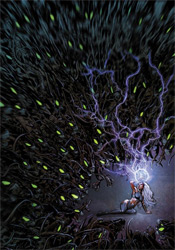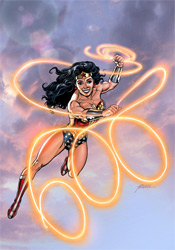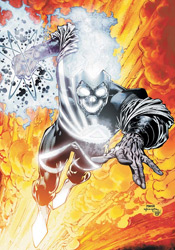
At least the issue's contents haven't gone sour during the months of neglect. After diving feet-first into the action in preceding issues, Warren Ellis spends a fair portion of this month sorting out the personal ramifications of what's gone wrong. A nameless villain has hacked into Hank McCoy's research database, using his investigations into reviving the mutant gene against the team on as grand and twisted a scale as one could imagine. It's not exactly a fresh idea, but that doesn't mean it no longer bears fruit. Ellis gives the Beast a sharp set of pages to stand up for himself under scrutiny, and as can be expected when a brainy, intellectual writer sinks his teeth into a brainy, intellectual character, the results are witty, brilliant and entertaining.
Pity the same can't be said for the whole of this month's dialog. It's universally quick-witted, snarky and sarcastic, even if that kind of attitude hadn't previously been in certain characters' playbooks. I can't say the punchlines don't ring true, because many are genuinely funny little self-deprecating jabs, but it gives the entire roster a homogenous, hive-minded aura that doesn't fit well with the team's history of individuality. I'd have no problem with this issue's writing if it involved a lesser-known set of characters, but when you're dealing with a squad of classics like Logan, Storm, Cyclops and Beast, some attention should be paid to their existing personalities. The issue is decently written, but the cast doesn't feel right.
Where Phil Jimenez provided the one really successful element of previous, more action friendly issues, he struggles with a more dialog-heavy chapter this month. In a frantic, chaotic fight scene, Jimenez seems right at home. He shows an eye for precision when the situation calls for detail and a knack for restraint when subtlety would be more successful. When the tone is more downplayed and the focus turns more toward character moments, though, he seems to second-guess his work and lose touch with that sense of timing. This month Jimenez over-renders the cast, particularly Emma Frost, crushing them under the weight of too much linework. His compositions feel heavy and thick, overburdened with an unnecessary amount of shadows. Tasked with illustrating a long conversation, he uses each panel to slowly zoom in on the speaker's face, to the point it starts to feel uncomfortable. In a few select panels, particularly the vast alien landscapes at the end of the issue, Jimenez shows a master's hand. The rest of his effort isn't quite up to par.
Astonishing X-Men has become a series both out of place and out of time. Its sister publications have already moved on to the next big crossover event, lessening the importance of the story's resolution. Ellis himself has even taken part, showing a much tighter grip of the same cast in Xenogenesis than is on display here. Chances are, you've already forgotten the purpose of the story after so much time away from the shelves. I'm here to tell you that, despite a few glimmers, what Ellis and Jimenez deliver this month isn't worth getting reacquainted with. It's become the lost adventure of a squad that's already done more adventuring than anyone could possibly keep up with. Flip through it if you're inclined, but don't take it home.
Overall Score: 3.5


